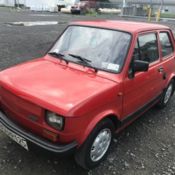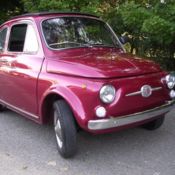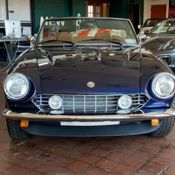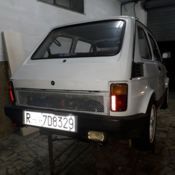Fiat 126p- Totally restored to show room condition.
Price: -
Item location: Stamford, Connecticut, United States
Description:
1980 Fiat Other
I'm selling Fiat 126p totally restored to the show room condition. This car is 100% rust free. Engine and transmission totally rebuilt. This car is a tribute of well know Fiats that were in Monte Carlo Rallys. I'm attaching real facts about the fiat.TheFiat 126(Type 126) is acity carintroduced in October 1972 at theTurin Auto Show[1]as a replacement for theFiat 500. Some were produced inBielsko-Biała Poland as thePolski Fiat126puntil 2000. It was replaced by the front-enginedFiat Cinquecentoin 1993.Engine capacity was increased from 594cc to 652cc at the end of 1977 when the cylinder bore was increased from 73.5 to 77mm.[3]Claimed power output was unchanged at 23PS (17kW) but torque was increased from 39N·m (29lb·ft) to 43 newton metres (32lb·ft).[3]The 594cc engines were still available in early 1983 production.The car was produced inPolandunder the brandPolski Fiat126p (literally in English:Polish Fiat 126p) between 1973 and 2000. At first it was almost identical with the basic model: differences included a higher chassis a modified grille on the back and the front blinkers that were white in Italy but orange for other markets. To distinguish it from the original Italian car the letter "p" was added to its name. It was produced by Fabryka Samochodów Małolitrażowych (FSM) inBielsko-BiałaandTychyunder ItalianFiatlicence. Throughout the 1980s the 126p was continuously modified. First it received upgraded brakes and new wheels from Italian Fiat hazard blinkers were added to meet new law requirements in 1985 tail fog light and factory back-up light were added to then standard plastic bumpers an electronic ignition system and alternator replaced undersized generator around 1987. The factory battery in 126p had only 35 Amp-hour capacity which combined with undersized generator resulted in never fully charged battery unless someone drove the car without stopping for extended time period. Some owners upgraded to a 45 Amp-hour battery from Fiat 125p (1.5 Liter engine) to improve the cold start reliability. Due to a relatively low price it was very popular in Poland and was arguably the most popular car there in the 1980s. Its very small size gave it the nicknamemaluch("the small one""small child" pronounced[ˈmalux]). The nickname became so popular that in 1997 it was accepted by the producer as the official name of the car.1989–1993 FSM Niki (Australia)It was exported to manyEastern Bloccountries and for several years it was one of the most popular cars inPolandand inHungaryas well. It also found a minor market in Australia between 1989 and 1992 under the nameFSM Niki. During that period it was Australia's cheapest car.[4]There was a convertible version developed for Australian market.Throughout the 1980s there were several experimental prototypes developed in Poland. A cargo version called "Bombel" (literally can mean "a bubble" but referred to a familial and alternative term for "small child") for its fiberglass bubble shaped cargo enclosure an off road version propelled by caterpillar tracks and a front wheel drive front engine with longer front end and flat cargo area in the rear where the original 126 had engine. The rear of this prototype was similar to the 126 Bis which also had a rear hatch for accessing the cargo space above the flat water-cooled engine hidden in the floor. There was also an attempt at installing a small diesel engine (due to gasoline rationing) in the classic 126p body.History of PF 126p- 1972 – the FSM car factory was built inBielsko-Biała.
- 6 June 1973 – the first Polski Fiat 126p constructed from Italian parts. The official price was 69000Polish złotyswithPKO Bank Polskiaccepting pre-payments on savings books starting 5 February 1973.[5]
- 22 July 1973 – the official opening of the factory's production line (by the end of that year over 1500 Fiats were manufactured).
- September 1975 – production started in a factory inTychy.
- 1977 – engine capacity increased from 594cc to 652cc. Engine power increased to about 24 horsepower (18kW).
- 1978 – production of types with engine capacity 594 cc ended.
- 1979 – production of Polski Fiat 126p continued only in Bielsko-Biała.
- 1981 – 1000000th Polski Fiat 126p produced.
- December 1984 – technical changes in the construction and body. TypeFLintroduced.
- 1987 – beginning of the production of the water-cooledPolski Fiat 126p Bisversion (704cc capacity).
- May 1993 – 3000000th Polish Fiat 126p produced.
- September 1994 – body improvement creating type "el" with parts similar to those used inFiat Cinquecento.
- January 1997 – introduction of acatalytic converter.
- 22 September 2000 – production ended after a production run of 3318674 units. All Fiats of the last limitedHappy Endseries were yellow or red (500 cars in red and 500 cars in yellow).
Vehicle Details:
- Make: Fiat
- Model: Other
- Type: Coupe
- Trim: base
- Year: 1980
- Mileage: 20,233
- VIN: SUF126A0008177578
- Color: White
- Engine size: 2 cylinder- air cooled
- Number of cylinders: 2
- Fuel: Gasoline
- Transmission: Manual
- Drive type: rear
- Interior color: Black
- Options: Leather Seats
- Vehicle Title: Clear Want to buy? Contact seller!








